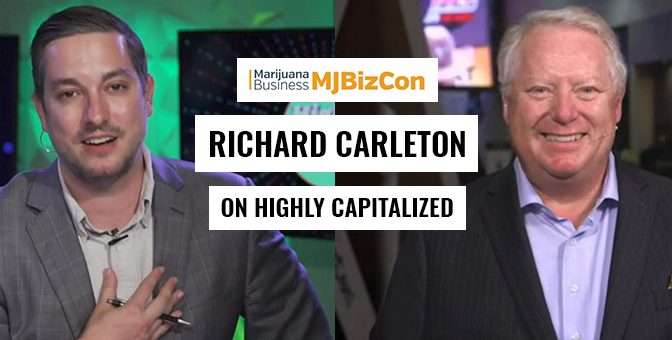CEO Richard Carleton was pleased to sit down with Greg Hasty from Highly Capitalized during MJBizCon Las Vegas to discuss the CSE’s position in the global cannabis space, how the industry as a whole is maturing, as well as M&A activity and brand building among US cannabis MSOs. Read the transcript of the interview below.
Greg Hasty:
Hey everyone. Welcome back to our continuous coverage of MJBizCon 2021. I’m Greg Hasty here in downtown LA at the HCN studios. And I have the pleasure of being joined by Richard Carleton, the CEO of the Canadian Securities Exchange. Richard, how are you doing?
Richard Carleton:
I’m doing well. Thanks Greg. Pleasure to be back at MJBiz in Las Vegas after a couple of years off.
Greg Hasty:
Absolutely. I’m very jealous. I’m already envious of you being on the floor while I’m stuck back here in the studio in LA, but great to see you again. Great to connect with you again.
Lots of changes, lots to talk about since the pandemic hit, but not all of them negative. Some really, really good developments in cannabis and adjacent markets. Tell us a little bit about what’s exciting you. What are you pumped about coming out of 2021?
Richard Carleton:
I think for people who don’t know who the Canadian Securities Exchange is, just a bit of a backstory, we made the fateful decision about five years ago to not just list companies from Canada in the cannabis space, but to begin to work with the industry in the US as well. And we really became the partner for the US multi-state operators to access public capital in Canada, and the United States as well. And all of the significant MSO operators who are public now are listed on the Canadian Securities Exchange.
We have roughly 160 odd companies in the cannabis space on the exchange overall. And it’s a significant percentage of our market capitalization, and daily trading turnover. From that strength, we have levered that position in the industry to work with companies from Latin America, South America, the Middle East, in particular, Israel, as well as Asia.
So we’ve really achieved a lot for a small Canadian startup. We’re now 20 years old, in a significant position in the cannabis finance space globally. So it’s been a wild ride up to the pandemic. And of course, we all had some uncertainty in the early days. And broader markets were certainly under extreme stress. But then by June, things had recovered dramatically, not just in the broader market, but in the cannabis market specifically when it became obvious that consumers were in fact rotating their purchases in the cannabis space and really supporting the industry in a big way.
And so, as the companies reported ever-improving results in Canada and the United States, increasing sales and moving towards profitability, that’s opened up a whole new range of opportunities for these companies to raise more capital and to begin to think about planting the flag in new states and new jurisdictions, and expanding their businesses organically.
Greg Hasty:
Absolutely. And I just love the journey that you’ve been on. I’ve been following you for at least six or seven years now and I remember even in my earliest interviews, people talking about getting involved with the CSE and how the CSE is really helping them get out there. And you really were the launchpad organization for so many businesses in the US, let alone businesses in Canada itself.
So talk to me a little bit about the current state of MSOs and Canadian businesses as well. There’s a lot of activity. M&A is a big thing right now. Tell us about the market shift and what trends you’re seeing.
Richard Carleton:
I think the important driver across the board here is a decreasing cost of capital for the large Canadian LPs and the US multi-state operators, with the number of opportunities that are opening up in new jurisdictions in the United States. We obviously have the tri-state area on the east coast. Michigan is obviously developing jurisdiction, Pennsylvania’s developing, maybe Ohio at some point in the not too distant future. They’re even talking about medical in Texas.
So there’s still tremendous opportunities for growth in the US markets, specifically. All told, I think it’s about a hundred billion a year between the illicit and the legal markets in the US now. So we know that there’s an enormous addressable opportunity for the operators to take advantage of, and they are. What we have seen is that companies from the US space, through the CSE, have raised more than $4 billion on a year-to-date basis.
That money is pretty much earmarked for mergers and acquisitions activity, as well as to build out in some of the states where they’re currently already operating. And again, there’s a significant cost of capital advantage. We’ve seen debt capital raised by a number of these companies that are now down in the single digits from a coupon perspective.
A year or two ago, companies were looking at 15% interest on debt. We saw last week an issuer raised debt at a 7% coupon. And the difference, of course, is that they have cash flows to secure that debt financing against, and so, the cost of capital has come down. They will use those advantages, as I say, to be very active in mergers and acquisitions activity, and they will continue to expand their footprint in the United States in particular.
Greg Hasty:
Do you see any difference in how MSOs are approaching M&A activity compared to what they were doing pre-pandemic? We saw a lot of MSOs build themselves up. And sometimes, it was a little “cart before the horse” in a lot of cases, and sometimes they would tackle almost too much in activity.
Are you finding that these MSOs that you’re working with and have partnerships with are being a little bit more strategic in their approaches? What’s kind of top of mind for them right now when they’re looking at different M&A opportunities?
Richard Carleton:
I think we understand well now where the value in the chain is highest. With cultivation assets, I think this is what you were saying was a big focus of investment in the early stages. And we now see over-capacity in a variety of regions in the United States, particularly California. Clearly that’s not going to be a source of margin for these companies moving forward.
It’s all about building brands, rationalizing your supply chain, and getting more and more product on the shelves, whether you own the dispensary, or through license agreements or agreements with recognized retailers, to get your high margin products in the hands of consumers. And I think that’s a sign of the increasing maturity of the industry, and understanding where future revenue and margin growth is going to come from.
Greg Hasty:
I’m personally really excited by that as a marketing and branding guy, to see people focus on consumer experience, on brand loyalty, on proper brand stewardship in cannabis, and not just cannabis-adjacent markets. You have psychedelics that are coming online. You even have technology companies that are now focused on the consumer experience and quality and stuff like that. So it’s really nice to see that maturity come into the industry, and it sounds like it’s just going to be more and more of a benefit for our partners moving forward.
Richard Carleton:
That’s absolutely right. And when we look at, for example, the Canadian LPs, they have real challenges in building brands because of the marketing and advertising restrictions that are placed on those companies.
That’s actually why you see the Canadian LPs wanting to invest into the US business lines, because that is where you’re able to develop those brands, and build consumer loyalty. Because again, this isn’t really the same as any other consumer packaged goods where you’re trying to build a brand from scratch because you know there’s an addressable market. You’re trying to win back share from the illicit market.
And so to do that, to command a bigger and bigger share of that brand loyalty and a successful consumer experience, it’s obviously going to be absolutely critical in winning that share.
Greg Hasty:
Wonderful. Well, Richard, I really appreciate your time. I love chatting with you. We can go so much deeper in the flow of the markets, but what’s wonderful about cannabis is that it’s always exciting and there’s always something going on. So every time we talk it’s a new and amazing adventure.
But that being said, the trend of maturity keeps going. Seeing these markets come online stronger, seeing these companies come back stronger is such an exciting thing. But thank you again, Richard, I love the chance to talk with you, and I hope you enjoy your time on the floor. Always make sure to check out the Canadian Securities Exchange on their website, and Richard, I believe you also have CSE TV, which is your social media outlet, correct?
Richard Carleton:
That’s correct. That’s our YouTube channel. We encourage everybody to subscribe. Through the pandemic, we’ve been doing a lot of our shareholder and company education through the medium of YouTube, as well as LinkedIn and Twitter and Facebook and so on. But we really like YouTube.
Greg Hasty:
Beautiful. So make sure to go on YouTube, check out CSE TV. Really great quality content. And they’ve really put in the work, especially over the pandemic. Richard, thank you again. It was great to see you. Make sure to also check us out on highlycapitalized.com to stay up to date on today’s events and all the interviews you may have missed, as well as the upcoming interviews. And make sure to follow us on LinkedIn and Facebook to stay up to date on our broader services. We’ll be right back. Stay tuned. See you for the next interview.
Richard Carleton:
Thank you.
To watch the full video interview, click here.













